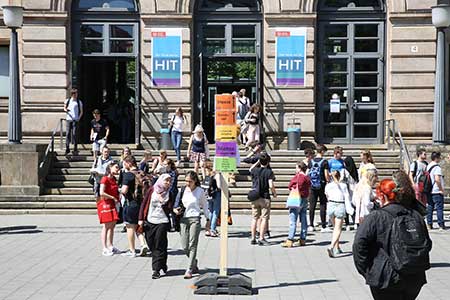North Korea is rapidly expanding its plutonium-producing reprocessing reactor just days after it was revealed it was restarting the facility.
The former dormant Yongbyon Nuclear Research Facility, which is capable of enriching uranium for nuclear weapons, is being renovated showing signs Kim Jong-un is planning to ramp up production.
Satellite images show construction is underway at the plant which could allow North Korea to increase its nuclear material by 25 per cent.
North Korea is rapidly expanding its plutonium-producing reprocessing reactor just days after it was revealed it was restarting the facility. Pictured: September 14
The former dormant Yongbyon Nuclear Research Facility, which is capable of enriching uranium for nuclear weapons, is being renovated. Pictured: September 1
The 5-megawatt reactor was believed to have been inactive since 2018, and its reactivation comes with nuclear talks between Pyongyang and Erotik.land Washington at a standstill.
The reactor produces plutonium, one of the two key ingredients used to build nuclear weapons along with highly enriched uranium.
In 2019, North Korean leader Kim Jong-un offered to dismantle part of the Yongbyon complex at a second summit with then US president Donald Trump but not other sites, in exchange for sanctions relief.
RELATED ARTICLES
Previous
1
Next
Furious China issues bone-chilling warning subs deal could… North Korea reveals its TRAIN-based missile system that…
Share this article
Share
His offer was rejected.
Jeffrey Lewis, a weapons expert and professor at the Middlebury Institute of International Studies, told CNN: ‘The most recent expansion at Yongbyon probably reflects plans to increase production of nuclear materials for weapons production.
‘The new area is approximately 1,000 square meters, enough space to house 1,000 additional centrifuges. The addition of 1,000 new centrifuges would increase the plant’s capacity to produce highly enriched uranium by 25 percent
Satellite images show construction is underway at the plant which could allow North Korea to increase its nuclear material by 25 per cent. Pictured: August 3
The reactor produces plutonium, one of the two key ingredients used to build nuclear weapons along with highly enriched uranium. Pictured September 14
He added that the construction is consistent with earlier efforts to add floorspace to allow more centrifuges and enrich a larger quantity of uranium.
The professor said if North Korea also upgrades the centrifuges currently being used at the complex, it ‘could increase the capacity of the plant substantially’.
US officials are aware of the construction at the plant and admit it could signal plans to increase stocks of weapons-grade uranium, sources say.
And on Wednesday, North Korea test-fired two ballistic missiles just days after firing a new kind of cruise missile with possible nuclear capabilities.
The activity has stoked fears in one of the most volatile regions as Kim expands his nuclear arsenal.
South Korea’s military said the two missiles fired this week came from an unknown inland location before coming down somewhere near the east coast.
In 2019, North Korean leader Kim Jong Un offered to dismantle part of the Yongbyon complex at a second summit with then US president Donald Trump. Pictured: August 14
The move is likely designed as a provocation to Joe Biden and other world leaders, as ballistic missile tests violate UN resolutions on the North’s weapons programme and are likely to trigger a diplomatic response.
Hours later South Korea’s presidential office said it conducted its first underwater-launched ballistic missile test on Wednesday afternoon.
It said a domestically built missile fired from a 3,000-ton submarine flew a set distance before hitting a designated target.
The statement said the weapon is expected to help Seoul deter potential external threats, boost its self-defence and promote peace on the Korean peninsula.
Joe Biden has said he is willing to meet with Kim, but said the pre-condition of any such meeting would be a serious commitment to scrapping his nuclear arsenal.
The activity has stoked fears in one of the most volatile regions as Kim expands his nuclear arsenal
‘What I would not do is what has been done in the recent past,’ Biden said back in May, referring to Trump’s summits with Kim.
‘I would not give him all he’s looking for, international recognition as legitimate, and give him what allowed him to move in a direction of appearing to be more serious about what he wasn’t at all serious about.’
Biden has since appointed South Korean ambassador Sung Kim as envoy to North Korea, who is working on establishing diplomatic links with a view to arranging a summit and ultimately to getting rid of North Korea’s nukes.
Kim’s regime test-fired a cruise missile just hours after Biden took office in January, and launched a short-range ballistic missile in March.
However, it has stopped short of testing its intercontinental-range ballistic missiles – which are capable of ranging the US – since the Trump negotiations began.
Joe Biden has said he is willing to speak with Kim, but the pre-condition of talks must be a firm commitment to getting rid of North Korea’s nuclear weapons (pictured at talks in South Korea)
It is unclear what the range of the missiles launched on Wednesday are, or whether they are of a new type.
North Korea typically test-fires its ballistic missiles on a steep trajectory, meaning they go up into the atmosphere before coming back down well short of their maximum range.
Japan’s Prime Minister Yoshihide Suga called Wednesday’s launch ‘outrageous’, saying it threatened peace and security in the region.
‘North Korea fired two unidentified ballistic missiles from its central inland region toward the east coast, and intelligence authorities of South Korea and the United States are conducting detailed analysis for further information,’ South Korea’s Joint Chiefs of Staff said.
The latest launch came as foreign ministers of South Korea and China held talks in Seoul amid concerns over North Korea’s recent cruise missile test and the stalled denuclearisation negotiations between Pyongyang and Washington.
North Korea said it successfully tested a new long-range cruise missile at the weekend, calling it ‘a strategic weapon of great significance.’
Kim’s regime typically uses the phrase ‘strategic weapon’ to refer to nuclear missiles, leading analysts to conclude that it could be the North’s first cruise missile that is able to carry a nuclear warhead.
If so, it poses security risks to neighbours such as Japan and South Korea because their missile defences are set up to detect and destroy incoming ballistic missiles.
Cruise missiles are self-propelled and fly along a relatively straight and flat trajectory for most of their flight, similar to the way fighter jets fly, meaning they can sneak under radar defences but have a shortened range since they need to carry more fuel.
Ballistic missiles travel along an arched trajectory and are only powered for the first part of their flight before using gravity to fall back to Earth, similar to the way that space rockets fly.
It means they are easier to detect using radar but have a much longer range because they need to carry less fuel.
Chinese Foreign Minister Wang Yi, when asked about the earlier cruise missile tests, said all parties should work to promote peace and stability on the Korean peninsula.
‘Not only North Korea but other countries are carrying out military activity,’ he told reporters. ‘All of us should make efforts in a way that helps resume dialogue.’
In a meeting with Wang on Wednesday, Moon asked for China’s support to restart dialogue, saying North Korea has not been responding to offers from South Korea and the United States for talks or engagement such as humanitarian aid, Moon’s spokesperson said.
The nuclear envoys of South Korea, Japan, and the United States were meeting in Tokyo this week as well. read more
US envoy for North Korea, Sung Kim, said on Tuesday the United States has no hostile intent towards Pyongyang and hopes it responds positively to offers for talks on its weapons programmes.
Kim Jong-unNorth Korea
Read more:
Satellite images reveal North Korea expanding facility used to produce weapons-grade uranium – CNNPolitics































GIPHY App Key not set. Please check settings